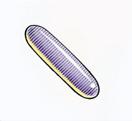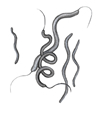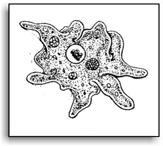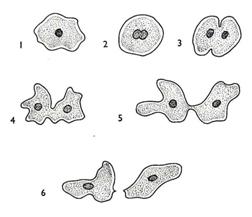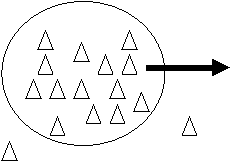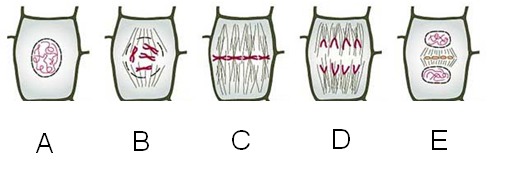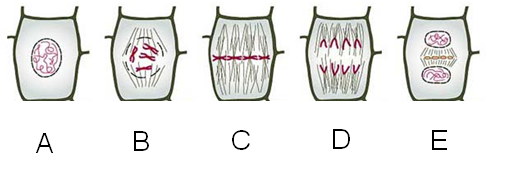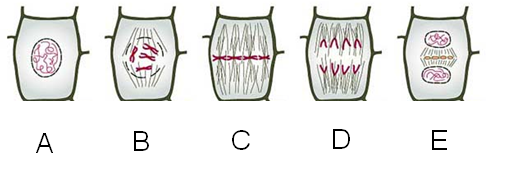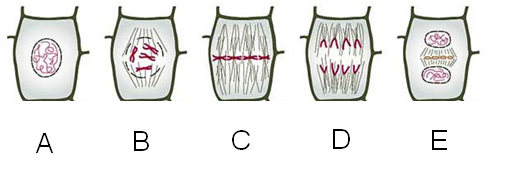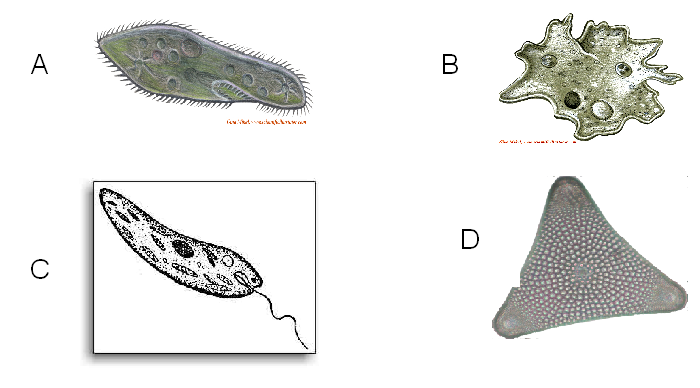Quarter 2 Assessment Review

Study for your Quarter 2 District Assessment!
- 1.
Identify the shape of this bacteria:
- A.
Cocci
- B.
Bacilli
- C.
Spirilla
- D.
Flagella
Correct Answer
B. BacilliExplanation
The correct answer is bacilli. Bacilli are rod-shaped bacteria, which can be seen as elongated cells under a microscope. They are characterized by their cylindrical or oval shape and can occur individually or in chains. This shape allows them to move efficiently through various environments and attach to surfaces.Rate this question:
-
- 2.
Identify the shape of this bacteria:
- A.
Cocci
- B.
Bacilli
- C.
Spirilla
- D.
Flagella
Correct Answer
A. CocciExplanation
The correct answer is cocci. Cocci is the plural form of coccus, which refers to a spherical or round-shaped bacterium. This shape is commonly found in bacteria such as Staphylococcus and Streptococcus. Bacilli are rod-shaped bacteria, spirilla are spiral-shaped bacteria, and flagella are thread-like structures that help bacteria with movement.Rate this question:
-
- 3.
Identify the shape of this bacteria:
- A.
Cocci
- B.
Bacilli
- C.
Spirilla
- D.
Flagella
Correct Answer
C. SpirillaExplanation
The correct answer is spirilla. Spirilla is a shape of bacteria characterized by a spiral or corkscrew-like structure. It is a type of bacteria that can be found in various environments, including soil, water, and the human body. Spirilla are typically larger than cocci and bacilli, which are spherical and rod-shaped bacteria, respectively. The presence of a spiral shape distinguishes spirilla from other bacterial shapes.Rate this question:
-
- 4.
Bacteria that live in extreme conditions are called...
- A.
Eubacteria
- B.
Cyanobacteria
- C.
Saprophyte
- D.
Archaebacteria
Correct Answer
D. ArchaebacteriaExplanation
Archaebacteria is the correct answer because it refers to bacteria that live in extreme conditions, such as hot springs, deep sea vents, and acidic environments. These bacteria have unique cell walls and membranes that allow them to survive in harsh conditions. They are distinct from eubacteria, which are more common bacteria found in various environments, and cyanobacteria, which are photosynthetic bacteria. Saprophytes, on the other hand, are organisms that obtain nutrients from decaying organic matter and are not specifically associated with extreme conditions.Rate this question:
-
- 5.
In this picture, name the part that is responsible for movement of this amoeba.
- A.
Nucleus
- B.
Pseudopod
- C.
Cell wall
- D.
Flagellum
Correct Answer
B. PseudopodExplanation
The correct answer is pseudopod. Amoebas are single-celled organisms that move by extending and retracting pseudopods, which are temporary projections of the cell membrane. These pseudopods enable the amoeba to change its shape and move in a flowing manner. The nucleus is responsible for controlling the cell's activities, not movement. The cell wall is a rigid structure that provides support and protection, but it does not play a role in movement. Flagella are whip-like appendages that some organisms use for movement, but amoebas do not have flagella.Rate this question:
-
- 6.
Which organism would be classified as a fungus?
- A.
Euglena
- B.
Mold
- C.
Tree
- D.
Archaebacteria
Correct Answer
B. MoldExplanation
Mold would be classified as a fungus because it is a type of fungus that grows in the form of multicellular filaments called hyphae. Fungi are eukaryotic organisms that obtain nutrients by decomposing organic matter in their environment. Mold fits this description as it obtains nutrients by breaking down organic materials such as dead plants or food. Additionally, mold reproduces by producing spores, which is another characteristic of fungi.Rate this question:
-
- 7.
Organisms that decompose other organisms and have nuclei in their cells belong to the _______________ kingdom.
- A.
Fungi
- B.
Animal
- C.
Plant
- D.
Eubacteria
Correct Answer
A. FungiExplanation
Organisms that decompose other organisms and have nuclei in their cells belong to the fungi kingdom. Fungi are known for their ability to break down and decompose organic matter, such as dead plants and animals. They obtain nutrients through the process of extracellular digestion, where they release enzymes to break down complex organic compounds into simpler forms that can be absorbed by their cells. Fungi also have distinct nuclei within their cells, which is a characteristic feature of eukaryotic organisms. Therefore, the correct answer is fungi.Rate this question:
-
- 8.
Which of the following is a kingdom?
- A.
Algae
- B.
Tree
- C.
Protist
- D.
Mushroom
Correct Answer
C. ProtistExplanation
Protist is the correct answer because it is a kingdom. The kingdom Protista includes a diverse group of eukaryotic microorganisms that do not fit into any other kingdom. They can be unicellular or multicellular and can be found in various habitats such as freshwater, marine environments, and soil. Protists are known for their diversity in terms of structure, nutrition, and reproduction. They include organisms like amoebas, paramecia, and algae.Rate this question:
-
- 9.
In this figure, what process is being shown?
- A.
Mutation
- B.
Asexual cell division
- C.
Sexual cell division
- D.
Osmosis
Correct Answer
B. Asexual cell divisionExplanation
The figure is likely depicting a process of asexual cell division because it involves the reproduction of cells without the involvement of gametes or the fusion of genetic material from two parents. Asexual cell division typically produces genetically identical offspring, which is consistent with the figure's representation. Osmosis, on the other hand, is the movement of water molecules across a semi-permeable membrane and is unrelated to cell division.Rate this question:
-
- 10.
The diffusion of water through a cell membrane is...
- A.
Osmosis
- B.
Fermentation
- C.
Equilibruim
- D.
Active transport
Correct Answer
A. OsmosisExplanation
Osmosis is the correct answer because it refers to the process of water molecules moving from an area of higher concentration to an area of lower concentration through a selectively permeable membrane, such as a cell membrane. This movement occurs in order to equalize the concentration of solute on both sides of the membrane. Osmosis is a passive process that does not require energy expenditure by the cell.Rate this question:
-
- 11.
Information about mitosis would most likely be found under which heading in a table of contents?
- A.
Protein building
- B.
Sexual reproduction
- C.
Asexual reproduction
- D.
Osmosis
Correct Answer
C. Asexual reproductionExplanation
Mitosis is a process of cell division in which a single cell divides into two identical daughter cells. It is a form of asexual reproduction as it does not involve the fusion of gametes. Therefore, information about mitosis would most likely be found under the heading "asexual reproduction" in a table of contents.Rate this question:
-
- 12.
Asexual reproduction results in new organisms whose genetic material is.....
- A.
Identical to the parent
- B.
Not identical to the parent
- C.
Half identical to the parent
- D.
Partially identical to the parent
Correct Answer
A. Identical to the parentExplanation
Asexual reproduction results in new organisms whose genetic material is identical to the parent. This is because asexual reproduction involves only one parent, and there is no exchange or mixing of genetic material between individuals. The offspring are essentially clones of the parent, inheriting the exact same genetic information.Rate this question:
-
- 13.
A cell that contains 70% water is placed in a solution that is 10% water. The cell and the solution will reach equilibruim when they both contain ________ percent of water?
- A.
80
- B.
30
- C.
60
- D.
40
Correct Answer
D. 40Explanation
When a cell with 70% water is placed in a solution with 10% water, water molecules will move from the area of higher concentration (the cell) to the area of lower concentration (the solution) in order to establish equilibrium. This means that water will continue to move from the cell into the solution until both the cell and the solution have the same concentration of water. Therefore, they will both contain 40% of water when they reach equilibrium.Rate this question:
-
- 14.
A semi-permeable membrane allows _____________ molecules to pass through.
- A.
All
- B.
Large
- C.
No
- D.
Some
Correct Answer
D. SomeExplanation
A semi-permeable membrane allows only certain molecules to pass through, while blocking others. Therefore, the correct answer is "some" because it indicates that only a select group of molecules are able to pass through the membrane.Rate this question:
-
- 15.
What process is occurring in this cell? = oxygen
- A.
Osmosis
- B.
Diffusion
- C.
Respiration
- D.
Transpiration
Correct Answer
B. DiffusionExplanation
Diffusion is the process occurring in this cell. Diffusion is the movement of molecules from an area of high concentration to an area of low concentration. In this case, oxygen molecules are moving from an area of higher concentration to the cell where the concentration is lower. This movement of oxygen molecules is facilitated by diffusion.Rate this question:
-
- 16.
What structure of the cell is duplicated during Interphase?
- A.
Cell membrane
- B.
Chloroplast
- C.
Mitochondria
- D.
Chromosome
Correct Answer
D. ChromosomeExplanation
During interphase, the cell undergoes a period of growth and preparation for cell division. One of the key events during interphase is the duplication of the cell's genetic material, which is stored in the chromosomes. Chromosomes are structures made up of DNA and proteins that carry the cell's genetic information. They are replicated during interphase to ensure that each new cell formed during cell division receives a complete set of genetic material. Therefore, the correct answer is chromosome.Rate this question:
-
- 17.
In this figure, what phase of mitosis is shown in picture B?
- A.
Prophase
- B.
Telophase
- C.
Anaphase
- D.
Metaphase
Correct Answer
A. ProphaseExplanation
The correct answer is prophase. This can be determined by analyzing the image in picture B. During prophase, the chromosomes condense and become visible, the nuclear membrane starts to break down, and the spindle fibers begin to form. By examining the image, we can see that the chromosomes are condensed and visible, indicating that the cell is in prophase.Rate this question:
-
- 18.
In this figure, what phase of mitosis is shown in picture C?
- A.
Prophase
- B.
Telophase
- C.
Anaphase
- D.
Metaphase
Correct Answer
D. MetaphaseExplanation
The correct answer is metaphase because in the given picture C, the chromosomes are aligned along the equator of the cell. This is a characteristic of metaphase in mitosis, where the chromosomes are condensed and attached to the spindle fibers, preparing for separation in the subsequent phase.Rate this question:
-
- 19.
In this figure, what phase of mitosis is shown in picture D?
- A.
Prophase
- B.
Telophase
- C.
Anaphase
- D.
Metaphase
Correct Answer
C. AnaphaseExplanation
The correct answer is anaphase because in picture D, the chromosomes are seen moving towards opposite poles of the cell. This is a characteristic feature of anaphase in mitosis where the sister chromatids separate and move towards opposite ends of the cell.Rate this question:
-
- 20.
In this figure, what phase of mitosis is shown in picture E?
- A.
Prophase
- B.
Telophase
- C.
Anaphase
- D.
Metaphase
Correct Answer
B. TelophaseExplanation
The given picture E shows a phase of mitosis where the chromosomes have reached the opposite poles of the cell and are starting to decondense. This phase is known as telophase. During telophase, the nuclear envelope reforms around the separated chromosomes, and the cell begins to divide into two daughter cells.Rate this question:
-
- 21.
Which of the following organisms woudl be classified in the SAME kingdom?
- A.
Euglena and fern
- B.
Ameoba and bacteria
- C.
Bacteria and fern
- D.
Euglena and amoeba
Correct Answer
D. Euglena and amoebaExplanation
Euglena and amoeba would be classified in the same kingdom because they are both unicellular organisms that belong to the kingdom Protista. Protists are a diverse group of eukaryotic microorganisms that do not fit into any other kingdom. They can be found in various habitats and exhibit a wide range of characteristics and modes of nutrition. Euglena and amoeba are both examples of protists, which is why they would be classified in the same kingdom.Rate this question:
-
- 22.
In this picture, which of the following protists use cilia for movement?
- A.
Paramecium
- B.
Amoeba
- C.
Euglena
- D.
Diatom
Correct Answer
A. ParameciumExplanation
Paramecium is a protist that uses cilia for movement. Cilia are hair-like structures that cover the surface of the organism and beat in a coordinated manner, allowing it to move through its environment. Amoeba, on the other hand, uses pseudopods or "false feet" for movement. Euglena uses a whip-like structure called a flagellum, and diatoms have a rigid cell wall and move by gliding or floating in water. Therefore, the correct answer is paramecium.Rate this question:
-
Quiz Review Timeline +
Our quizzes are rigorously reviewed, monitored and continuously updated by our expert board to maintain accuracy, relevance, and timeliness.
-
Current Version
-
Mar 22, 2023Quiz Edited by
ProProfs Editorial Team -
Oct 28, 2010Quiz Created by
Marvin Johns
- Academic Quizzes
- Adult Learning Quizzes
- Blended Learning Quizzes
- Coaching Quizzes
- College Quizzes
- Communication Quizzes
- Curriculum Quizzes
- Distance Learning Quizzes
- E Learning Quizzes
- Early Childhood Education Quizzes
- GCSE Quizzes
- Grade Quizzes
- Graduation Quizzes
- Kindergarten Quizzes
- Knowledge Quizzes
- Literacy Quizzes
- Physical Education Quizzes
- Qualification Quizzes
- Religious Education Quizzes
- School Quizzes
- Special Education Quizzes
- Study Quizzes
- Subject Quizzes
- Teaching Quizzes
- Theory Quizzes
- Thesis Quizzes
- University Quizzes
 Back to top
Back to top



